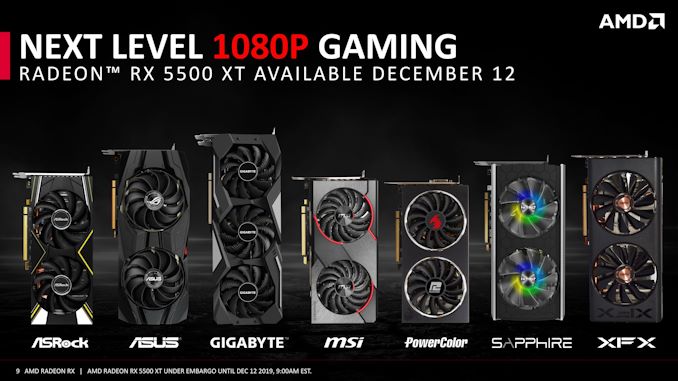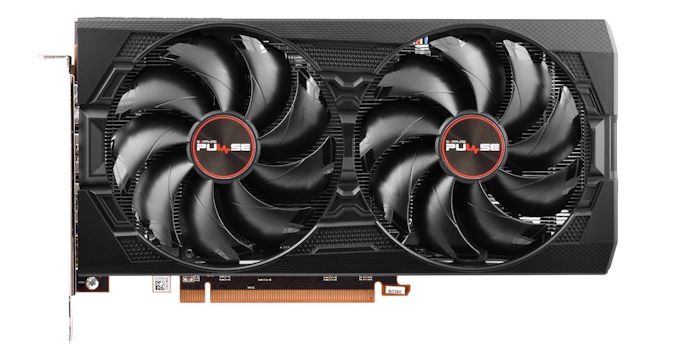The AMD Radeon RX 5500 XT Review, Feat. Sapphire Pulse: Navi For 1080p
by Ryan Smith on December 12, 2019 9:00 AM ESTClosing Thoughts
While the launch of the Radeon RX 5700 series and the underlying Navi 10 GPU was not a slam dunk for AMD’s GPU division, it was none the less an important achievement. The combination of the new RDNA core architecture as well as TSMC’s 7nm process gave AMD a significant kick in both performance efficiency and power efficiency. And in the process, it set a template for all the Radeon RX 5000 series cards to follow.
So it shouldn’t be too surprising then that the new Radeon RX 5500 XT gets to enjoy much the same situation. Compared to AMD’s previous generation Polaris-based RX 500 series cards, the 1080p-focused RX 5500 XT delivers better performance, and it does so while drawing noticeably less power. Even compared to their NVIDIA rivals, AMD is generally competitive on power efficiency in a class of cards where they were well behind in the previous generation.
Competitive performance, meanwhile, is a bit of a trickier subject. As the replacements to the RX 570/580/590 within AMD’s stack, the RX 5500 XT almost always beats AMD’s older cards, the one odd exception to this being Metro Exodus. As a result, AMD’s cheaper 4GB RX 5500 XT looks especially good here, reaching performance parity with NVIDIA’s recently launched and similarly priced GeForce GTX 1650 Super. As is usually the case, the cards are anything but equal on a game-by-game basis, constantly trading wins and losses, but at the end of the day they’re fighting over the same market with the same performance.
The 8GB RX 5500 XT, on the other hand, faces tougher competition. The extra VRAM helps to boost its performance and its price, putting it in competition with NVIDIA’s somewhat awkwardly placed GTX 1660. The GTX 1660 is an odd man out as the only current-generation GDDR5 card among the contenders, and yet it’s still fast enough to remain several percent ahead of the 8GB RX 5500 XT. To be sure, AMD’s new card puts up a great fight, coming closer to meeting NVIDIA in both performance and power efficiency than any previous AMD card; but at the end of the day it’s not enough to completely close the gap with NVIDIA’s closest competitor. Which is not to say that the RX 5500 XT is entirely outclassed here, but the GTX 1660 leads by just enough that it can’t be entirely ignored.
| Performance Summary (1080p) | ||||
| Relative Performance | Relative Price |
|||
| RX 5500 XT 4GB vs GTX 1650S | 0% | +6% | ||
| RX 5500 XT 8GB vs GTX 1660 | -8% | -5% | ||
| RX 5500 XT 8GB vs RX 580 8GB | +8% | +11% | ||
| RX 5700 vs. RX 5500 XT 8GB | +60% | +60% | ||
Throwing a wrench into all of this however – for both AMD and NVIDIA – is VRAM capacity. VRAM isn’t cheap, and GDDR6 even less so, so both vendors are using VRAM capacity as product differentiators and to upsell their better cards. But as VRAM capacity in the $150-$200 price range has been pretty stagnant for the last couple of years now, I do have some concerns about the long-term implications for the 4GB RX 5500 XT, especially with the next-generation consoles set to launch in a year’s time. With the consoles setting the baseline for most multiplatform games, it’s a reasonable bet that VRAM requirements aren’t going to stay put at 4GB much longer. So while the 4GB RX 5500 XT is a great value now, I suspect it’s going to run out of VRAM well before its compute performance gets to be a bottleneck. And while NVIDIA’s GTX 1660 fares better here with its 6GB of VRAM, 6GB is still not 8GB.
Overall then, the VRAM situation adds an extra wrinkle to any kind of product recommendations, as it’s one more variable that deserves consideration.
At the end of the day, I don’t think any 4GB cards are a great choice right now. For buyers who absolutely cannot afford to spend more than $169, then the 4GB RX 5500 XT or NVIDIA’s GeForce GTX 1650 Super counterpart are both going to be the best choices you can make right now, at least among the current-generation cards. However, spending another $30 to get a better card is going to get you a card with at least 6GB of VRAM and 6% more perforamnce, and that’s going to remain relevant for a lot longer than a 4GB card will in 2020.
Choosing between the 8GB RX 5500 XT and GTX 1660, on the other hand, is a bit harder. AMD has a 2GB VRAM advantage, which is likely to be helpful in the future; but right now they can’t match NVIDIA’s performance or feature advantage. Ultimately I’m not sure there’s a clearly correct answer here – at least, not one that can be backed entirely with hard data. In the meantime however, as the second to market it's up to AMD to make a convincing showing if they want to dislodge NVIDIA's existing GTX 1660.
As for Sapphire’s Pulse RX 5500 XT in particular, it’s hard to envision a better card to show off the Radeon RX 5500 XT. If you can look past the card’s somewhat ridiculous size for its class, the product as a whole is just about everything you could want out of a reference clocked card. The build quality is solid, the included TriXX software is handy, and the acoustics are incredible. It may not be a silent card, but with two giant fans to push plenty of air with ease, it may just as well be.
And with that, AMD is set to wrap up their GPU lineup for 2019. At only 3 Navi cards in, AMD is far from done in fleshing out a complete, top-to-bottom family of video cards. But for now, AMD is able to hit the mainstream and performance segments, which is a good place to stop for a bit and reflect as we go into the holidays.












97 Comments
View All Comments
YB1064 - Thursday, December 12, 2019 - link
Poor man's NVidia indeed.flashbacck - Thursday, December 12, 2019 - link
What do you mean by that?Valantar - Thursday, December 12, 2019 - link
Apparently the same performance at the same price with a better encode/decode block and better idle power usage but slightly worse gaming power usage and buggy OC controls equals "poor man's Nvidia". Who knew?assyn - Thursday, December 12, 2019 - link
Actually the Nvenc is better encode/decode because has wider format support and can decode 8K videos, while the AMD only capable of 4K.Valantar - Thursday, December 12, 2019 - link
The 1650 and 1650S have a cut-down NVENC block lacking pretty much every single improvement made with the Turing generation. Not all NVENC is equal.Ryan Smith - Thursday, December 12, 2019 - link
1650S has a full NVENC block. It's based on TU116, not TU117.jgraham11 - Friday, December 13, 2019 - link
Seems like this will be similar to the GCN cards in the past (RX5XX Series), at the beginning its ok, then over the years AMD's fine wine kicks in. Making incremental improvements that improve overall performance with every driver release. Do realize they are still using the GCN instruction set but RDNA is a new architecture, an architecture that will be in both the Xbox and PlayStation systems.WaltC - Saturday, December 21, 2019 - link
I feel as though AMD has hobbled this card. They put the GDDR6 VRAM onboard, effectively doubling more or less the bandwidth of GDDR5, but then they took it all back with the 128-bit bus...;) I think they missed an opportunity here--but I'm not privy to the manufacturing particulars for the product--so maybe not. Anyway, it seems like they might have made the 5500XT a GDDR6 8GBs, 256-bit bus GPU for $279; then made the 5500 with 4GB, and a 128-bit bus for ~$129 or so. The SPs by themselves are sufficiently cut down to the degree that even a 256-bit bus GPU like I've dreamed up here is going to be sludge next to a 5700--or, that should certainly be the case, I would think. The card almost seems "overly hobbled" to my way of thinking. I think that @ 256-bit 5500XT, 8GBs of GDDR6 might've been a smash seller for AMD @ a ~$279 MSRP, leaving the 5700 still clobbering it simply based on the much higher number of SPs. I just see a lot of potential here that seems overlooked--unless they have plans for a 5600XT, maybe, early 1 Quarter 2020....;)WaltC - Sunday, December 22, 2019 - link
Will someone please set me straight on whether this is an 8-lane PCIe card? I'm reading this stuff you-know-where but it doesn't make any sense at all to me. It's claimed that accordingly the 5500XT runs much faster on PCIe4 than PCIe3. Eh?https://www.reddit.com/r/Amd/comments/edo4u8/rx_55...
RX-480/580/590 are all PCIex16 GPUs with 256-bit buses running GDDR5. Is the article linked here factual? thanks--to whomever can answer....;) Doesn't sound probable to me--but if it's true then AMD has hog-tied this card six ways to Sunday--trussed up tighter than a Christmas piglet...;)
WaltC - Sunday, December 22, 2019 - link
OK, I saw the one line in the review I missed first time about "I suspect 8 PCIe lanes"--just very strange--I don't understand this product at all! Perhaps the full incarnation of the GPU is going into the PS5/XBox 2, it's just weird. To have to hobble it that much, the GPU must be very robust.